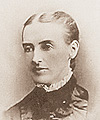
|
 |


| 1885 |
Eiwa Jo Gakko School founded at what is presently Daimyo 2-chome, 10-31 Jennie Gheer, Founding Principal |

Jennie Gheer,
Founding Principal |
| 1916 |
May Queen and maypole dance initiated on the anniversary of the universityfs founding |
| 1921 |
The first gsailorh-style school uniform (blouses and caps) system in Japan implemented |
| 1937 |
Ms. Helen Keller visits |
| 1947 |
New system junior high school established |
| 1948 |
New system high school established |
| 1955 |
Kindergarten established |
| 1960 |
Campus moved from Hirao to the Kamiosa area of Fukuoka City |
| 1964 |
Junior College established |
| 1990 |
University: Faculty of Humanities established |
| 1999 |
University: Faculty of Human Relations established |
| 2002 |
Tenjin Satellite Campus established |
| 2003 |
Graduate School: Humanities Research Course established
University: Department of English as a Global Language established in the Faculty of Humanities & Childcare Workerfs Course established in the Faculty of Human Relations |
| 2004 |
Graduate School: University received the gType 1 designated graduate schoolhdesignation for certifying clinical psychologists |
| 2005 |
120th anniversary of the universityfs founding celebrated |
Founder Ms. Gheer comes to Fukuoka with fervent hopes
It was 1885 and Jennie Gheer, a female American missionary with sincere hopes and dreams, arrived in Fukuoka City's Tenjin 2-chome (known at the time as Inaba-cho), a sparsely populated area that had yet to resemble anything like a real city. Ms. Gheer was dispatched by the Christian Methodist church in the United States and given the mission to propagate Christianity in Japan. Constantly holding dear to her heart the ideal of a gschool where Japanese girls can find a new way of lifeh, Ms. Gheer conveyed the gospel of Jesus Christ from an antiquated house and began the education of young girls there. An institute of education with its humble beginnings in this old house later evolved into the Eiwa Jo Gakko girls' school, the predecessor to Fukuoka Jo Gakuin. |
A motto of nurturing individuals,
Embraced in our school emblem
The motto of Fukuoka Jo Gakuin is based on the Christian teachings that Jennie Gheer introduced more than 120 years ago: gFearing God, living in service of Him, and nurturing women as excellent members of societyh. At Fukuoka Jo Gakuin we believe that, in order to foster fine members of society who live in the service of God in this way, it is first of all necessary for teachers and staff alike to deal with each and every student on a one-to-one basis. The current educational emphasis at Fukuoka Jo Gakuin of watching over each individual with care and attentively fostering their true potential comes from that motto, and there is deep meaning as well in the school's emblem that is beloved by a great many graduates and attending students alike. Depicted in that emblem is a bunch of grapes from the gvineh, found in the words of the Gospel according to John, with the design containing 11 connected grapes. Symbolizing the desire for all persons related to Fukuoka Jo Gakuin to be connected in a single line, for them all to be firmly connected by the single hope contained in the teachings of Christianity, this single bunch of grapes, drawn in a single stroke, was thus adopted as the school emblem. |
From the hardships of a burnt down schoolhouse,
To today's comprehensive educational institution.
From pre-Second World War, a time of gradually strengthening militarism and the deterioration of Japan-U.S. relations, through to the end of that war, Fukuoka Jo Gakuin survived an era of true turbulence and suffering. Amongst the various forces and pressures of that time, the school overcame that season of raging storm by keeping the school emblem of a bunch of grapes connected in a single line close to heart. By the end of the war, even the schoolhouse had been burnt down in the bombing, but, at a time when many thought that all had been for naught, what school director Yoshi Tokunaga felt as she stood atop the ruins of the fire was not a sense of despair. Rather, it was a vision of fostering women who would create a new age and a feeling of hope for the future. Her dream was as fervent as Ms. Gheer's and overflowed with the strength to forge ahead. She later constructed a schoolhouse in the area of present-day Osa (in Fukuoka City's Minami Ward) and, before long, it grew into a comprehensive educational institution with a kindergarten, junior high school, high school, junior college, university, and graduate school, progressing towards the Fukuoka Jo Gakuin that exists today. This was the beginning of a site of lifelong learning intended for participating members of society and Fukuoka Jo Gakuin, which while educating the women who will serve that society, will continue to move forward with the times. Having entered its 123rd year in 2008, we are eagerly looking to the future, connected with all people of the human race through a single line. |
|


 |

